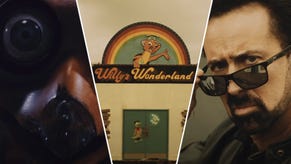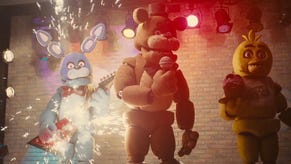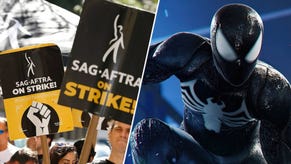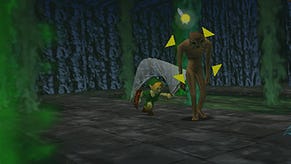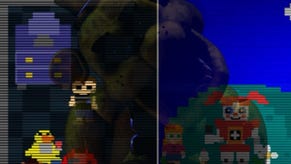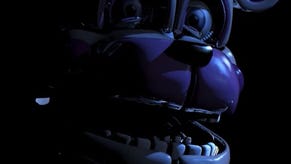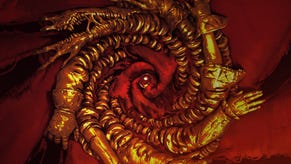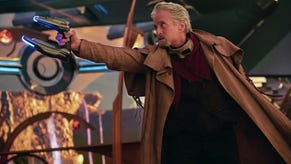Murder, Dysfunctional Families, and Purple Guys: The Larger Story Behind the Five Nights at Freddy's Games
When you peer behind the jump-scares, the narrative driving the Five Nights at Freddy's games is dark, disturbing, and sad.
This article first appeared on USgamer, a partner publication of VG247. Some content, such as this article, has been migrated to VG247 for posterity after USgamer's closure - but it has not been edited or further vetted by the VG247 team.
Welcome, Freddy Fans (and a special welcome to parents who are trying to figure out what the heck their kids are raving about). This guide to the lore behind the Five Nights at Freddy's games aims to make the over-arching story as digestible as possible.
When I first published this guide to Scott Cawthon's wildly popular horror-adventure series in 2015, Five Nights at Freddy's 3 had only just been announced. Since then, we've had a fourth, fifth, and sixth game (including DLC), three novels, a strategy guide that doubles as a lore premier, and an RPG. In other words, some of the story points I talked about previously have been expanded upon. Some have changed. Others have flown out the window entirely.
Here, I use all available information to summarize the Five Nights at Freddy's storyline as simply and plainly as possible. I talk about the kids who were killed, who killed them, and the killer's motivations.
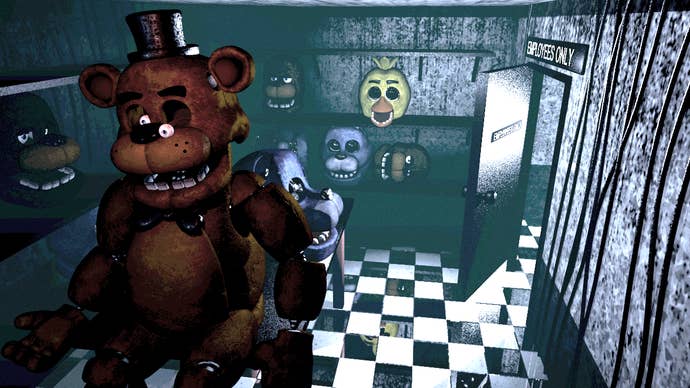
The lore behind Five Nights at Freddy's is dense and intimidating stuff at first glance, but when you focus, it isn't too hard to follow. With a little effort and tenacity, you'll uncover a twisted tale that not only involves murder and deceit, but also a broken family that tries to project itself as normal with depressingly limited success.
Hardcore fans will certainly notice I omit certain plot threads and side-facts, like Michael Afton's possession by Ennard. That's by design: I try to keep things simple here. You won't find irrelevant information about the characters, nor will you find much in the way of fan speculation and theories. While I touch on some of the points MatPat makes in his extremely popular Five Nights at Freddy's videos (specifically his "Final Theory" videos [Part One] [Part Two]), most of what's here is based on fact—or at least widely-accepted fan theories.
Cawthon has a very dry sense of humor, and he enjoys stringing his fanbase along. He even created a kind, grandfatherly hippo animatronic who advises players they shouldn't look too deeply into stories (watch out for the jump scare at the very start of the video). I try to focus on hard facts for this summary of the series' story, but "hard facts" don't mean a whole lot in the Five Nights at Freddy's universe. Take everything here with just a pinch of Fazbear-brand garlic salt.
Eat your pizza, don't get too close to the stage, and enjoy.
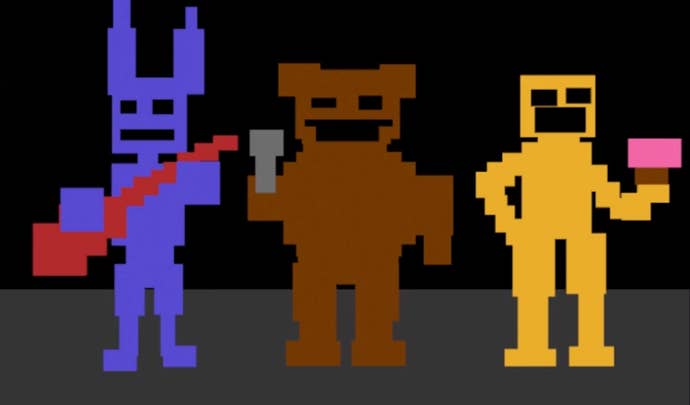
"Let's start at the start. What is Five Nights at Freddy's?"
Five Nights at Freddy's (FNAF) is a series of point-and-click horror games for PC and mobile made by independent game developer Scott Cawthon. The game's setting varies from game to game, but the premise between them remains the same: You, looking through the eyes of the games' protagonists, must stay alive for five or six days against an onslaught of animatronics who want your blood.
At the time of this writing, there are five mainline FNAF games:
- Five Nights at Freddy's (2014)
- Five Nights at Freddy's 2 (2014)
- Five Nights at Freddy's 3 (2015)
- Five Nights at Freddy's 4 (2015)
- Five Nights at Freddy's: Sister Location (2016)
- Freddy Fazbear's Pizzeria Simulator, Plus Ultimate Custom Night (UCN) DLC (2017/2018)
There are also a few supplementary works:
- "The Silver Eyes," a young adult novel based on the series
- "The Twisted Ones," a follow-up to "The Silver Eyes"
- "The Fourth Closet", a conclusion to both The Silver Eyes and The Twisted Ones"
- "The Freddy Files," a strategy guide that also offers some additional lore
- "The Five Nights at Freddy's Survival Logbook," a game and activity book
- FNAF World, a cutesy RPG that half-parodies the series it's based on
As you can see, Cawthon produced the first four FNAF games very quickly, but he's since slowed down his output in favor of applying polish and new ideas to the series. Sister Location, for example, frequently changes up the nature of the hazardous situation you need to survive. By contrast, previous games just make the existing animatronics act more aggressively night after night.
"What parts of Five Nights at Freddy's are canon, and what aren't?"
FNAF 1 through Pizzeria Simulator are all canon, and their stories tie into each other. FNAF World isn't canon. On the Steam Community for Five Nights at Freddy's 4, Cawthon explained that The Silver Eyes and The Twisted Ones are sort-of canon, but it's not meant to fit snugly with the games. Rather, the books are an alternate retelling of the games' events.
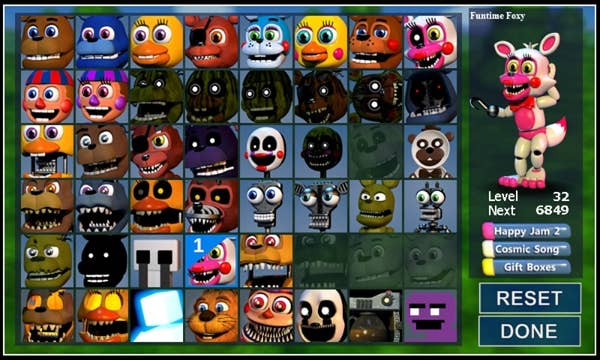
For the purposes of letting everyone hang onto their sanity, this guide focuses on the story points revealed through the mainline FNAF games.
"Who's the protagonist of the Five Nights at Freddy's games?"
Even though FNAF's main protagonist is mostly mute and featureless (with very few exceptions, you never see anything except what's directly in front of you, including physical characteristics or markings), the player character has an identity. "You" are Michael Afton, a physically and emotionally tormented young man trying to undo the grievous sins committed by his father in the pizza parlors he owned. We'll cover Michael Afton and his father in more detail later on.
The first two games put Michael in the role of a security guard keeping an eye on things at night. The third game thrusts him in "Fazbear's Fright," a horror attraction based around a burned-out Fazbear Pizzeria location. The fourth game changes things up a bit: You play as a frightened child, probably Michael's younger brother, trying to fend off nightmare versions of the popular FNAF animatronics from your bedroom (we'll also explore Michael's younger brother later on). In Sister Location, Michael tries to free his sister's remains and / or soul from the shell of one of the animatronics. In Freddy Fazbear's Pizzeria Simulator, Michael works with one of his father's old business partners to bring peace to the restless souls of the children who were murdered in various Freddy Fazbear establishments across the country.
I'll say it for you: "Wow. That escalated quickly."

Regardless of whom you're playing as in any of the games, your only real job is to survive. Depending on the game, your method of doing so varies. You may have to monitor cameras and lock your security doors when appropriate, or you may have to listen for audio cues and perform certain actions to ward off the animatronics when the time is right. In most games, your range of movement is limited, and you certainly don't have access to any weapons.
"Do all the games take place at the same pizzeria?"
No. There's more than one Fazbear Entertainment-branded pizzeria, including the titular Sister Location. But not all the games revolve around a restaurant or some other variation of a Satanic Chuck E Cheese-style venue. FNAF 4 takes place in a kid's bedroom, and Sister Location takes place in an underground bunker populated by animatronics that are queued up for repairs and reprogramming.
"I've heard the animatronics in the Five Nights at Freddy's games are haunted by the ghosts of dead kids. Uh, is that true?"
Yes, for the most part. Though FNAF is a bloodless series, it's kind of grim. As stated above, there are several Fazbear-branded pizzerias, and most have been struck by accidents and tragedies—including serial child murders.
Using hidden newspaper clippings and delightfully retro mini-games / cutscenes that emulate Atari CES game sprites, FNAF and FNAF 2 hint that several children were killed at the restaurant and had their bodies hidden inside animatronics backstage. This caused the angry souls of those kids to possess the series' most recognizable animatronics: Freddy Fazbear, Bonnie Bunny, Foxy, and Chica the Chicken.
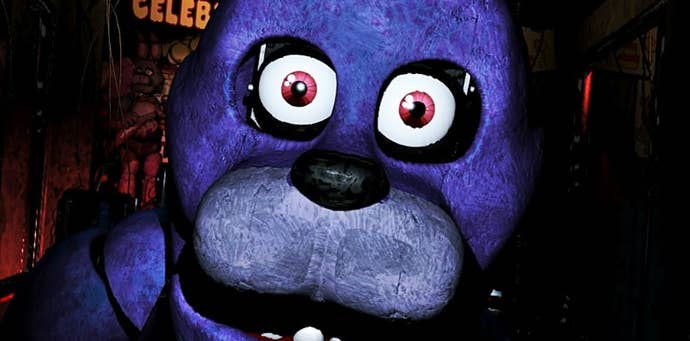
There are also several lesser-known animatronics, including "Golden Freddy" (sometimes called "Fredbear") and "Marionette," who were also possessed by dead children's souls.
Interestingly, the mini-games in FNAF 2 indicate the animatronics are driven to protect other children and find their killer. Consequentially, the animatronics are mistrustful of adults, i.e. the player.
FNAF 4 and Sister Location focus less on the dead kids, and instead offer us a profile about the man who committed the crimes.
"How did the kids die?"
Horribly, presumably. But there's a little bit of good news. Like FNAF 2, FNAF 3 has supplemental Atari-style mini-games that let you play through several connected scenarios. If you complete them successfully, you learn that the ghost-kids who possessed Freddy, Bonnie, Foxy, Chica, Golden Freddy, and the Marionette get revenge on the man who killed them, then move on to a better place. So, that's a cheerful bit of closure for a series that tends to lack anything in the way of cheerfulness or closure.
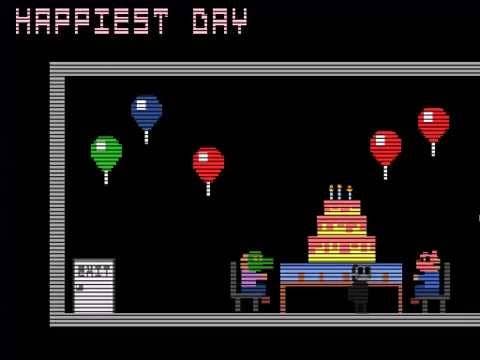
"Who is Five Nights at Freddy's 'Purple Guy?' And why have I heard so much about him?"
Now the fun begins.
There are actually two "Purple Guys." The most important one is William Afton, a genius animatronics engineer who designed and built the series' animatronics we know and (kind of) love. He's also the one behind the child-killings mentioned in FNAF 1, FNAF 2, and FNAF 3.
The second Purple Guy is Michael Afton, William's son. Michael is the main character in Sister Location.
The first Purple Guy, William, got his nickname because his first appearance is in FNAF 2's mini-games, where he appears as a purple Atari-style sprite. He wasn't given the name William Afton until much later. Purple-William is surrounded by dead children when we first meet him in FNAF 2. The dead kids are also represented as simple Atari-style sprites, but they're still pretty unsettling to see.
The second Purple Guy is William Afton's son, Michael Afton. Though Michael is the protagonist of Sister Location (more on that below), we didn't see him take on the form of Purple Guy #2 (hereafter referred to as "Purple-Michael") until Scott Cawthon made a new Atari-style cinema scene for players who beat the Custom Night in Sister Location's Very Hard mode.
Neither William nor Michael are literally purple human beings. Their purple hue is simply a stylistic choice Scott made when creating the characters who, again, were introduced through retro mini games purposefully designed to look like Atari titles. Scott's work is filled with tributes to very old games, a fact that usually sails over his young fans' heads for understandable reasons.

Purple-William's weird grin is befitting of a child murderer. He also seems to understand the spirits of the kids are haunting the animatronics. In fact, he receives an ironic death in the last FNAF 3 mini-game: He tries to hide from the kids' ghosts inside an animatronic shaped like a yellow bunny, only to have it snap shut and impale him.
But Purple-William didn't die. His zombified corpse, now tangled up in the mechanics of the rabbit animatronic that skewered him, "lives" to haunt the player as an animatronic named "Springtrap" in the events of FNAF 3.
Note that while the events of FNAF 3 take place 30 years after the events of FNAF 1 and FNAF 2, its mini-games are set in the past and show you Springtrap's origin.
"So the first Purple Guy, William Afton, is the one who killed the kids? Did the second Purple Guy, Michael Afton, kill any?"
William is outright seen killing children in the FNAF 2 mini-games. His son, Michael, is innocent—mostly. Michael did kill a child, but it was an accident. In fact, his role as the FNAF series' protagonist suggest he's trying to find redemption for what he did.
More on that below.

"So the Afton Family is responsible for all the bad things going down in the Five Nights at Freddy's Series?"
Pretty much. It's not surprising, either. Despite William Afton's genius, and despite the fact they all live in an idyllic neighbourhood and project an outward appearance of being normal, they're a dysfunctional bunch.
FNAF 4 and Sister Location link together to give us an idea of what the Afton family is like. There's William Afton, the patriarch and owner of at least one Fazbear Pizzeria. There's Michael, his older son. There's also a nameless, perpetually fearful little boy who fans call "the Crying Boy," and a little girl named Elizabeth.
The opening cutscene for Sister Location indicates William Afton has a thing for designing and populating his restaurants with animatronics that kill children. In fact, one of his most popular animatronics, a female clown called "Circus Baby," kills his daughter, Elizabeth, after luring her close with an ice-cream cone). William had warned his daughter to stay away from the animatronic, seemingly to no avail.

William's youngest son, the Crying Boy, died in a similar fashion. Despite being terrified of his father's animatronics (hence his perpetual crying), Michael put his little brother's head in Freddy's mouth. The mouth unexpectedly clamped down, and the boy died some time later.
(Popular fan theory even suggests Crying Boy is terrified of animatronics because he witnessed Circus Baby murder his sister, but there's no confirmation one way or the other.)
"What's William Afton's motivation for killing those kids?"
William's motives are hazy, but we can take a stab (sorry) at a couple. A hidden cutscene in Freddy Fazbear's Pizzeria Simulator suggests young William built robots as a way to cope with having an abusive alcoholic for a father—though since the game never gives us the explicit identity of "The Orange Guy" in that cutscene, we can't say he's William's father for certain.
More hidden lore in Pizzeria Simulator suggests William uses the souls of his young murder victims in experiments regarding immortality. When the kids' souls are "bound" to an animatronic, it's capable of living forever. William's former business partner, Henry, was an unwitting accomplice in these experiments. He helps Michael bring William to a fiery end at the conclusion of Pizzeria Simulator, then allows himself and Michael to be immolated by the flames.
Also consider William Afton might simply be a mad genius. If he loves anyone, it's daughter, Elizabeth, hence why he was strict about not letting her approach Circus Baby. He knew what the animatronic was capable of, and he didn't want her to get hurt. "Sweetie, don't let the crazy death-contraption I built kill you" is a low bar to measure a caring father by, but it's the only indication that William Afton is any kind of a human being.
It's also worth noting Elizabeth (whose soul is trapped in the Circus Baby animatronic) and William (as Springtrap) still seem to care for each other in a twisted way, but William clearly cares nothing for his sons, Michael and the Crying Boy. Michael tortures his little brother in FNAF 4's mini-games by destroying his toys and constantly scaring him while wearing a Foxy mask. In time, Michael's pranks go too far and kill the Crying Boy. William doubtlessly knew his younger son was miserable before his death—all the other neighborhood kids make fun of him for his constant weeping—but he does nothing to stop the torment. In fact, he schedules the Crying Boy's birthday party at the pizzeria, despite the Boy's obvious fear (yes, the Crying Boy was mortally wounded on his birthday. Uplifting!).
More unsettlingly, before his death, the Crying Child spends time in a comatose / dreaming state that sees him fend off monstrous versions of the animatronics he fears (this makes up the gameplay portion of FNAF 4). In Sister Location, we learn William Afton has—or had—surveillance of his son's sickroom beamed down to a secret room in the bunker where he built and fixed his animatronics.

Was the Crying Child comatose and simply dreaming about fighting his worst nightmares? Or was he semi-lucid and his father set actual animatronics after him as some kind of twisted psychological experiment? We don't know for sure, but the implications are deeply disturbing.
Finally, William sent his eldest son, Michael, down to his old work-bunker to free Elizabeth's soul / remains from Circus Baby, even though William probably had a good idea that his son would get wrecked by vicious animatronics and / or vengeful spirits (Michael's act of freeing Elizabeth's soul is what makes up the events of Sister Location; since he shows remorse for getting his brother killed by apologizing to him in the ending of FNAF 4, there's a strong possibility he trusts his father just enough to earn a chance at redemption for accidentally killing his younger brother) . When Michael monologues to his father (who we see for a second as Springtrap) at the end of Sister Location, it's clear he's not happy about being deceived.
Freddy Fazbear's Pizzeria Simulator concludes with William's old business partner, Henry, luring the series' haunted animatronics (the ones who didn't find peace at the end of Five Nights at Freddy's 3) into one spot with Michael's help. Henry then sets the pizzeria aflame with himself, Michael, and William (as Springtrap) inside. Before they all burn up, Henry suggests his "old friend" might be doomed to spend eternity in darkest pit of Hell for his murders.
The downloadable content for Pizzeria Simulator, "Ultimate Custom Night," contains a hidden ending where a character who's an in-game representation of Scott Cawthon himself—a simple red sprite calling himself "Old Man Consequences"—informs you "the demon is with his demons." In the background, we hear an eerie, chopping sound that's actually a voice sample slowed way down. When the sample is sped up, a choppy, robotized voice screams and curses the names "Mike" and "Henry." It would indeed appear William Afton got everything he deserves.
"What's in the locked box shown at the very end of Five Nights at Freddy's 4?"
Scott Cawthon knows. The good Lord knows. I do not.





